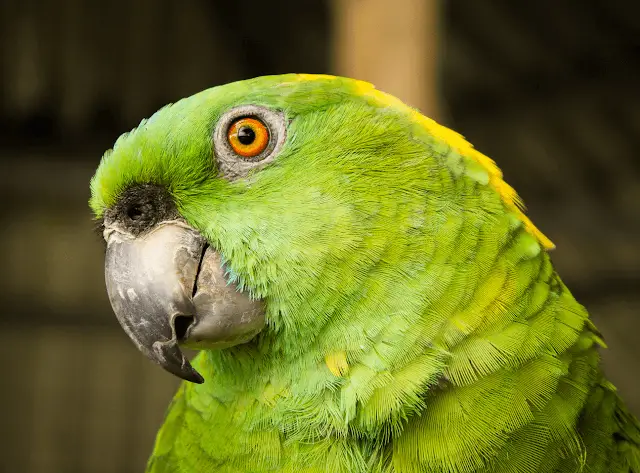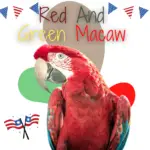
Yellow-naped amazon:Régime juridique: CITES Appendix II, freeholding not subject to quotas Order: Psittaciformes Famille:Psittacidae
Sex: No sexual dimorphism
Phenotype:
- Green parrot with a pronounced yellow on the nape, a green mask, and red remiges. The pattern of colors is very variable from one individual to another
Character: bird able to speak (a few words and great impersonator of noise) even if it is quite destructive. Amazons are reputed to be very stubborn and should not be recommended to a beginner
Weight: 350 – 400g
Yellow-naped amazon parrot

Scientific name: Amazona barbadensis
Order: Psittaciformes
Family: Psittacidae
Kind: Amazona
Size: about 33 centimeters.
Longevity:
Distribution: Yellow-naped amazon parrot Quite widespread on the northern coast of Venezuela, it has disappeared from the island of Aruba while there are only 800 individuals left on Margarita Island, about 100 in La Blanquilla and no more than 400 in Bonaire.
Description: Like most species of this genus, it has a green plumage with brilliant reflections due to the black border of the feathers. His forehead is white. The cap and periocular areas are yellow, as are the shoulders and panties.
The green of the cheeks and throat is washed azure. A red wing mirror marks the first four secondary remiges. Irises are orange and white orbitals circles. The beak is of horn color tinged with pink. The wax is undeveloped while the nostrils are very apparent.
Subspecies: Amazona barbadensis (located on the coast of Venezuela), Amazona barbadensis rothschildi (yellow on the head and wings less extensive and slightly shaded with orange), also in this region but also in the Netherlands Antilles.
Yellow-naped amazon

Amazona ochrocephala
Yellow-fronted Amazon (Amazona ochrocephala ochrocephala) Physical description
Chunky bird with entirely green plumage with some red flight feathers. The forehead is yellow with an almost perfect triangle between orange-brown eyes, circled in white with a black iris. Its beak is meaty with a lighter part on the sides. Its legs are robust and dark.
The Panama Yellow-fronted Amazon is slightly smaller than its counterpart and the triangular yellow spot on its forehead is more marked.
Amazon yellow-necked Parrot
SOURCE:Karen Fisher
Size
35 cm
Lifetime
40 years
sex
scientific sexing
Reproduction
Box-nest
Good result with a united couple with a spacious aviary and quality food.
Incubation: 21 days
Flight of the young: 60 days after birth
Origin
Colombia and northern Brazil
Behavior
Moderately-noisy to noisy, bold, careful, but quickly confident with those around him; he needs to snack and likes to bathe; appreciate being able to fly in an aviary. Tame, is very sociable with a real ability to adapt. Very attached to his master who can teach him to speak and a few tricks: he loves to play and is one of the best speakers among the Amazons.
Washington Treaty
Appendix II
Food
The mixture of safflower seeds, wheat, oats, hemp, berries; buckwheat and beans; the sunflower; some pines or nuts; several fruits and vegetables; half-ripe corn; mineral supplements.
Amazona auropalliata
The Golden-naped Parrot, or Amazona auropalliata, is native to Mexico, Honduras, Nicaragua, Costa Rica, Guatemala and El Salvador. It was identified by Lesson in 1842 and kept in captivity from that time by the Indians of Central America, seduced by its pleasant character.
It measures about 35 cm, weighs 480 to 680 g, and can live for about sixty years. Its bright green plumage is characterized by a yellow band located in the nape. This is not visible in juveniles and only appears between one and four years of age.
It develops gradually until it reaches its final size and color. Its beak is a mixture of black and beige, its pupils are orange and its gray legs, are extended by black claws. There is no sexual dimorphism in this Parrot species. Sexing, therefore, requires the use of a DNA test.
It lives in pairs or in small colonies in the natural state, occupying the forests located between 500 and 700 m, the maquis, and the savannah. She is very good at learning to speak compared to the other varieties in her family if she is willing to play this game of human communication. Learning a human language is also an excellent substitute for his cries.
Because this Amazon is no exception to the rule of its congeners, by being very noisy. Pleasant and fairly easy-going, she is as intelligent as she is obedient with the proper education. This greatly facilitates taming but also learning games with his master.
This Amazon perceives herself above all as a small person, it is up to her human being to “deal with”. She enjoys the company of humans as well as that of animals. With patience and time, strong bonds are woven with its owner, whom it will learn to trust. The most difficult course to pass is around five years.
A period of strong hormonal surge then extends over one or two years. It is marked by great aggressiveness, which largely fades or subsequently disappears outside of breeding or the season associated with it.
Its diet is based on a seed mixture that does not contain too many sunflowers. The extrudates do not contain enough phytonutrients, they are not recommended as a food base, but can be given to him occasionally.
However, a daily intake of beta-carotene is essential for its health. This is done through fresh fruits and vegetables such as carrots, chard, and sweet potatoes in addition to the daily ration. Sprouted seeds are also beneficial to their balance.
To allow a confirmed and mature couple to reproduce, a nest of 30 to 35 cm in diameter and 80 to 100 cm high is necessary. The opening should measure between 10 and 12 cm.
The breeding season begins between April and May. The female lays about three eggs then incubates them for 26 to 28 days, fed by the male. The young leave the nest between eight and twelve weeks. Their rigid feathers grow from four weeks. At ten weeks, they are nearly feathered and beginning to learn how to roost. Sexual maturity occurs between four and five years.
The Golden-naped Parrot falls into the IUCN category of Least Concern. There is a blue mutation, but this one is overpriced and very rarely available inbreeding.
Yellow-naped amazon price
How much does an Amazon parrot cost? Depending on the species chosen, the price will differ. To compare the different prices of Amazon parrots, we will take the example of the three main species mentioned beforehand.
The price of a Yellow-fronted Amazon parrot from a breeder varies between 850 dollars and 1000 dollars. Blue-fronted Amazon parrots are often more expensive: their price varies from one breeder to another and the price range is between 1,000 dollars to 1,200 dollars. And finally, the price for a red-fronted Amazon parrot corresponds to the prices of blue-fronted Amazon, i.e. between 1,000 dollars to 1,200 dollars.
As you have noticed, the purchase of an Amazon is of the significant cost associated with the long life of the parrot, so it is necessary to think carefully so that the bird and owner live in perfect harmony with this exceptional relationship. In addition, the maintenance of an Amazon parrot generates financial costs for the year due to the purchase of balanced food and toys… Indeed being very playful, to distract your parrot, games will have to be made available to him. Its powerful beak will often deteriorate the toys and they will have to be changed.
To conclude, we hope that through this article you will know more about this extraordinary parrot and that this information will have enabled you to make your decision. Indeed, an Amazon parrot requires a lot of time, attention, and of course love.




















